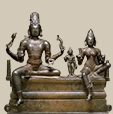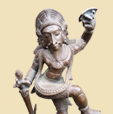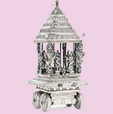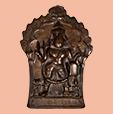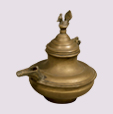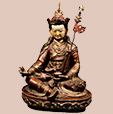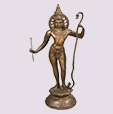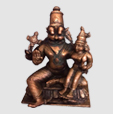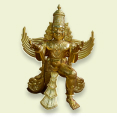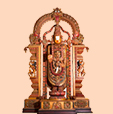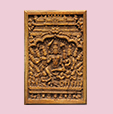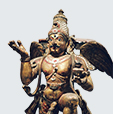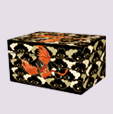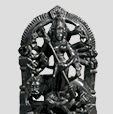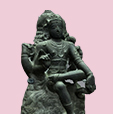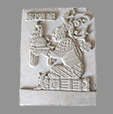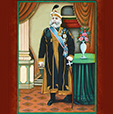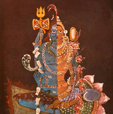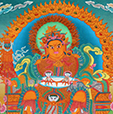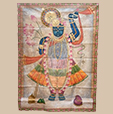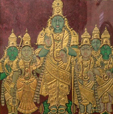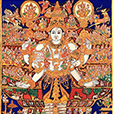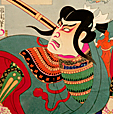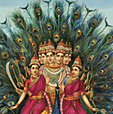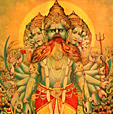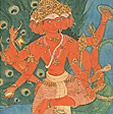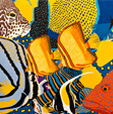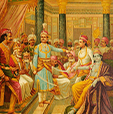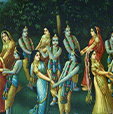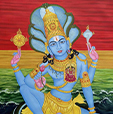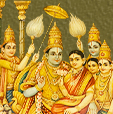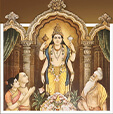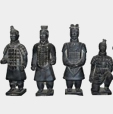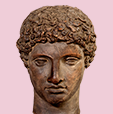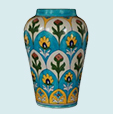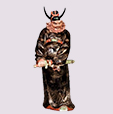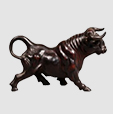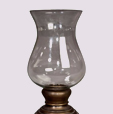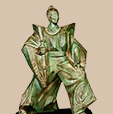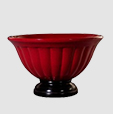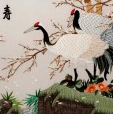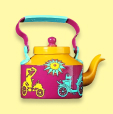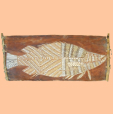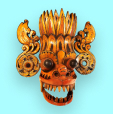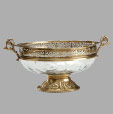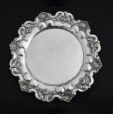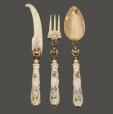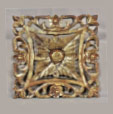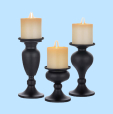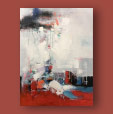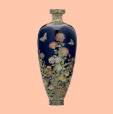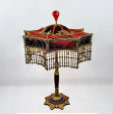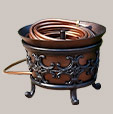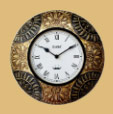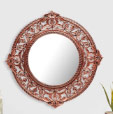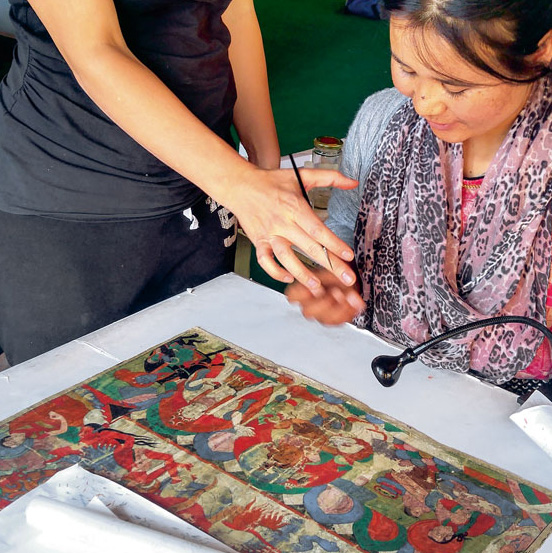
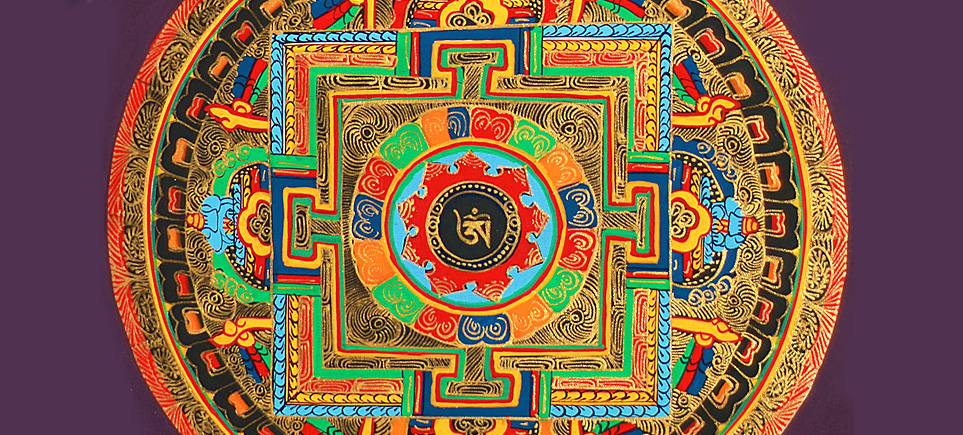
Thangka paintings involve more than artistic skills. To be able to sketch Tibetan Buddhist deities that form the theme of most of the Thangkas, the artist must have expert-level knowledge of measurements and proportions of Buddhas, Bodhisattvas, and other deities as outlined in Buddhist iconography. These deities of Tibetan Buddhism run in thousands. Artists have to rely on a grid of precisely positioned lines to sketch.
Sketching involves a basic system of these coordinates having one vertical and two diagonal lines. The center of any Thangka painting is an intersection of these three lines. And where Thangkas have figures other than the central one, there are additional connecting lines and circles contrasting these background figures with the central figure.
Since the grid system divides the Thangka painting into parts with different proportions and also lends fluidity to a Thangka painting, should a Thangka painting be done, say twice the original size, the artist need only double the dimensions or distance between all lines.
It is hard to surmise the expertise, knowledge, and artistic skill that has gone into a completed, impressive Thangka painting that looks nothing less than divine. We have briefed the process of creating a traditional Thangka painting into the following thirteen steps to give our readers an appreciative view of this sacred Tibetan art or your newly acquired Thangka painting.
While certain elements of Thangka paintings stand changed since artists have had to paint in exile, much of Tibet’s traditional styles and techniques were thankfully retained laboriously.
We hope the below will interest and enlighten you on this Sacred Art of Tibet.
"Exquisite, Original Tibetan Buddhist Thangka Art for Sale. Buy Tibetan Thangka, Buddhist Thangka Paintings created by master Tibetan artists".
1. A Pure Motive First
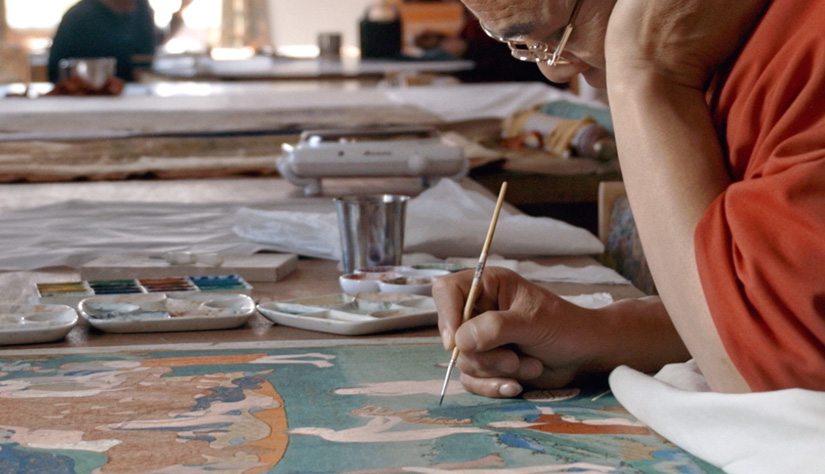
In traditional Tibetan thought a Thangka Painting is a fruit of a sacred human-endeavor involving: a lama, a religious seeker and a Thangka artist.
This step doesn’t relate directly to Thangka Painting production but is an important step nevertheless since it sets the spiritual premise for a Thangka Painting which isn’t a mere commodity but a manifestation of enlightened energy.So much so that there is no discussion on price when the seeker engages the artist. While it has become necessary to set prices for Thangka Paintings these days, tradition is that seeker pays artist any payment he deems fit or may afford and artist feels happily grateful regardless of the payment size.
The seeker first identifies a deity-image among the Tibetan pantheon that is most conducive to his spiritual practice after counsel of a learned Tibetan Buddhist lama. Subsequently he invites a Thangka painter to his house, hosting him will great hospitality during the Thangka painting process. In case the deity in the requested painting is particularly difficult or unusual the artist consults with the lama to clarify aspects of the image.
For the finished Thangka painting to bring the right spiritual benefits to the seeker and creating it worthy of seeker’s offerings and meditation, artist ensures he paints with a selfless, joyful mind. The seeker on his side refrains from rushing the artist and observes patience.
The Thangka painting so created with combined spiritual aura of a realized lama, true seeker and concentrated painter renders the finished Thangka Painting a sacred work of art.
2. Preparing The Canvas
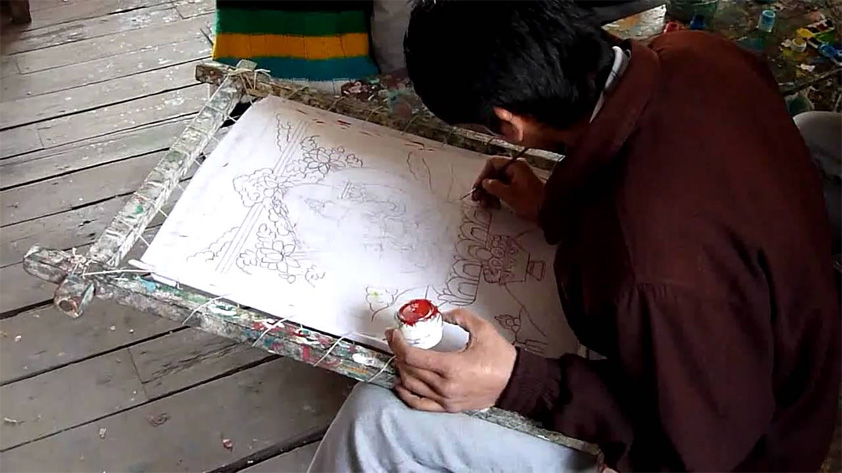
The cloth to be painted undergoes a complex 14 – 20 day process depending on local climate. In cold foggy Himalayan foothills of Nepal for example, canvasses for an entire year are processed in dry weather of March, April, October and November months. An improperly processed canvas will waste all efforts in a Thangka Painting.
The cloth is first neatly sewn onto four lengths of bamboo, tightly strung to a large wooden frame. The artist then spreads glue over the entire canvas and leaves it to dry. He then creates a thick-cream like mixture of glue, white clay and water by stirring them together in a clean pot. Sanctified medicines and sacred substances may be added too if available.
Once this second coat has dried up the canvas is held up to the light and any sections not coated evenly are patched up with more mixture and again left to dry. This is repeated 8 – 10 times till the entire canvas is evenly coated.
The canvas is then laid upon a smooth wooden board and a small area is moistened with water using a soft white cloth. Section by section, the artist vigorously rubs the canvas smooth with a piece of white marble, moistening it with water as he works. This takes about an hour. The entire canvas is then slowly and carefully stretched by tightening the strings tied to the frame and left to dry in indirect sun.
Once dry, the entire procedure is repeated for the other side of the canvas, stretching it after each moistening and leaving it to dry. When it has been thoroughly treated and dried, the canvas comes out so tightly stretched that it makes a nice drum sound when tapped. This is an indication it is ready to be painted. The front of the canvas is then polished with a conch shell.
3. Foundational Line Drawing
At this stage the artist bathes, takes purification vows at dawn, meditates upon his tutelary deity, and performs rituals to clear away obstacles and harmful spirits. Having studied the description of the image to be painted in a religious text and consulted a lama about any confusing details, the artist recites the sacred syllables of the Buddha or deity in question and begins to draw.
Ideally, the artist recites these syllables and visualizes the deity for the entire duration of creation of the Thangka Painting. It may be evident how Thangka Paintings are inherently sacred and quite different from ordinary works of modern art.
The foundational lines are done in pencil (followed by black ink in old Tibet) and take between 10 to 30 days to complete, depending on the size and complexity of the Thangka Painting.
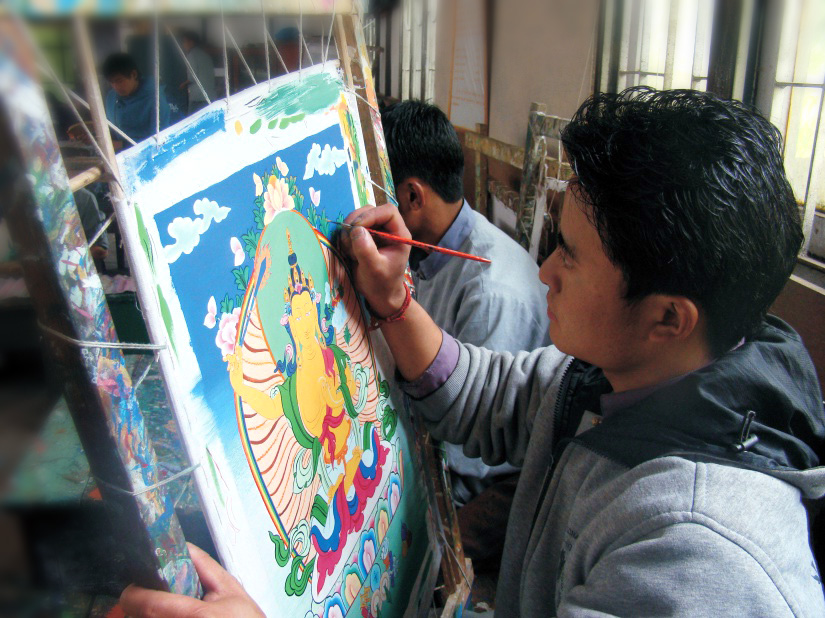
4. Mixing Paint
There are five primary colors in a traditional Thangka Painting and it takes a full day to prepare these. Traditionally, the materials included a variety of mineral and vegetable substances: minerals, precious stones, bark, leaves, flowers (especially the rock rose), gold, silver, copper, etc. Each had to be collected from its source in different areas of Tibet , cleaned, ground, powered, crushed or cooked.
It is a pity that these days artists in exile tend to opt for easily available chemical based pigments. Natural materials should be used as far as possible in any work of Thangka Painting.
While mixing each color, artist tests it continuously by applying it on the edges of the canvas and letting it dry since paint reveals its true color after drying completely.
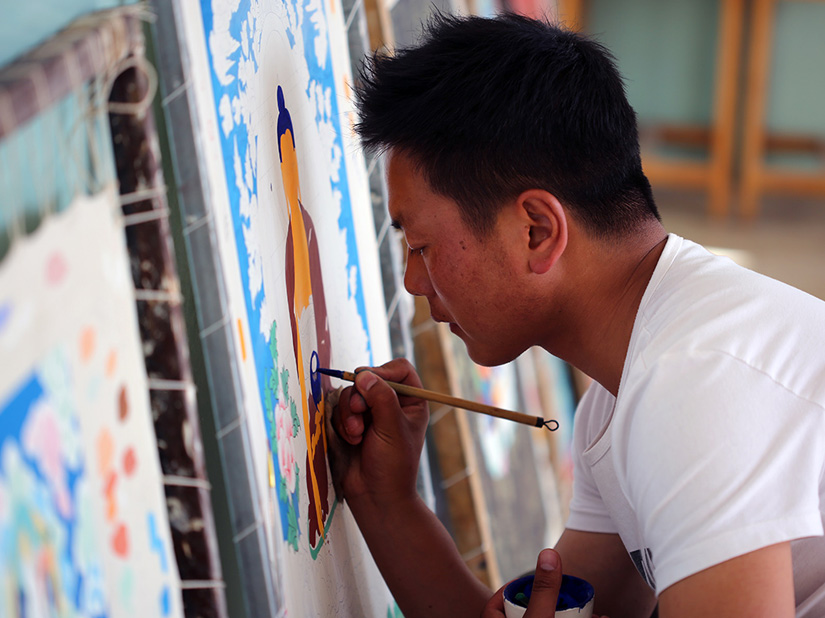
5. Making Paint Brush
Traditional paintbrushes were made out of several different materials. For painting on rough surfaces, brushes were made out of Nama grass, a tough grass growing along riverbanks. For medium soft brushes, the hair of horses’ tails was used. For soft brushes of any size, the tufts of hair growing above goats’ hooves, the fine hair inside cows’ ears, the fur of otters, the very soft feathers of mountain songbirds, and the fur of brown and black cats (especially in India where the other hair and fur is not available) are perfect for painting.
It takes 3 to 4 days to make about 20 high quality brushes. The handle of the brush is a slender piece of upward growing bamboo cut just above the joint. One-inch long hair clipped from the animal has to be carefully mixed with powder and sorted to find hairs that resemble a needle in shape. These are carefully extracted and laid side by side perfectly evenly.
Then they are very carefully inserted into the bamboo in such a way that all the hairs lie together in a cone shaped point. They are seized in between the fingertips and dunked into glue. The bamboo is also dunked in the glue, and the hair is then inserted into the bamboo. Each hair must be perfectly in place. Then a string is carefully tied around the bamboo, not too tight and not too loose. The brushes are then left to dry.
6. Painting
There is a definite, specific sequence to color application. In general, the Thangka Painting is painted from top to bottom. The first step is the sky, which takes 3 to 6 days. An initial deep blue wash is followed by innumerable slender, length wise brush strokes to produce a stipple effect of lines. Then all the blue parts of the Thangka Painting(water, clothing, etc.) are filled in.
The dark green landscape and all the dark green areas are next. This is followed by light blue, then light green, red, orange, pink, brown, pale orange, yellow, pale yellow and finally white. When the whole series of base coat colors have been applied and allowed to dry, the Thangka Painting is scraped with a razor blade, held at an arched angle to the cloth, to smoothen away any roughness in the paint. The dust is brushed off with a soft cloth or feather.
7. Redrawing And Shading
The original detailed lines of the clouds and flowers, which get covered by paint, are redrawn in pencil and traced over in black ink. The artist then shades them with a fine paintbrush. In general, a Thangka Painting needs three applications of paint, but flowers require many repeated applications of thin paint to give them their effect of inherent radiance. A single flower may take 3 to 7 days to complete.
8. Details
Painting the intricate details of the back and foreground landscape and brocade clothing designs follows the same sequence of color application as above. This takes 18 to 20 days to complete.
9. Body Shading And Final Painting
The artist then shades in color to give shape to the figure’s body and face. The flowers are given final shading and all the minute background details such as fish, deer, birds, fruit and countless grass blades are painstakingly painted.
10. Gold Application
A considerable quantity of gold is used to highlight and give a Thangka Painting its final glorious touches. This entails a strenuous, complex process. Preparing the gold takes 7 to 10 days and applying it takes an additional 6 to 25 days. The artist generally purchases about 50 grams of gold at a time (no more than five grams are applied to a single Thangka Painting) and employs a goldsmith to heat, clean and beat it into sheets.
The artist cuts the sheets into tiny pieces and puts them in a mortar with water and grain sized pieces of marble or glass. He grinds the mixture until the bits of marble or glass are reduced to dust particles. More water is added and the mixture is covered and allowed to stand overnight. By morning, the gold has sunk to the bottom and the milky mix of marble water is dumped off.
This process is repeated with addition of glue, and each morning for seven days the surface water is poured off. Finally, only glue is added to the gold and this mix is vigorously ground to extract any remaining impurities. The artist then evenly heats a metal sheet over a medium flame. Adding water and a little glue, he drops tiny dollops of gold onto the hot metal.
The water evaporates and the gold hardens into little pellets. A few of these are then dissolved in water, glue and egg white or juice of Sema grass seed. After the gold has been applied to the thangka, it is polished with a gZis stone.
11. Opening The Eyes
This is the most important moment of a Thangka Painting artist’s work. Before painting the figure’s eyes, the artist bathes and makes offerings to Buddha’s body, speech and mind. When the eyes have been painted, seed syllables and prayers are inscribed on the back of the Thangka Painting to awaken the image’s energy.
12. Brocade
Final 4 to 6 days elapse while the tailor affixes a brocade frame to the completed Thangka Painting.
13. Consecration
The practitioner takes his or her newly completed Thangka Painting to a highly realized Buddhist master and makes offerings to request the master’s blessings.
The master, endowed with the clear mind of enlightenment, is able to “bring alive” the image on the Thangka Painting by infusing it with energy and beseeching the deity to open its eyes and look upon all sentient beings. The Thangka Painting, having now been properly consecrated, is a receptacle of wisdom. It is ready to be hung and venerated as a genuine living embodiment of enlightened mind.
It is important to note that this final step is only necessary if the Thangka Painting artist himself is a realized being. Over the centuries, many important Buddhist masters have intentionally taken rebirth as Thangka painters, and if such an artist creates a Thangka Painting, the very mind of the artist naturally consecrates the image being painted. In such cases, there is no need to seek the services of a lama for additional consecration.
While these Thangka Painting making process or method, steps provide a guide in achieving desired visual effects required for the creation of quality Thangka Painting, one must be aware that it is essential to combine these processes with correct motivation, philosophy and creative ability to obtain a Thangka Painting of excellence.

